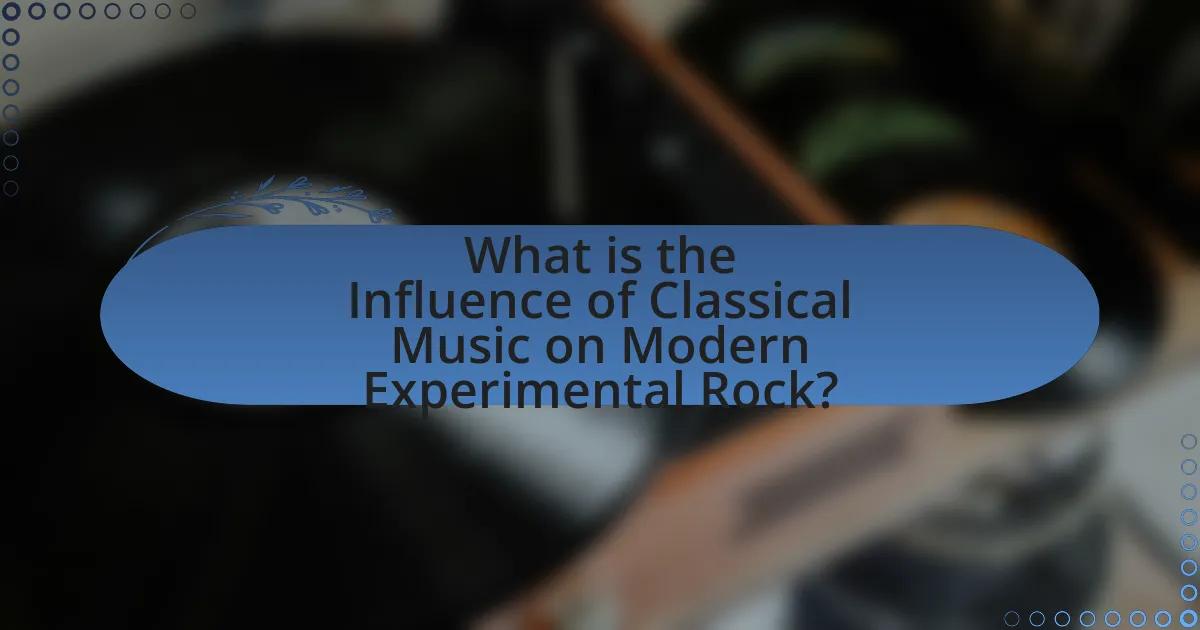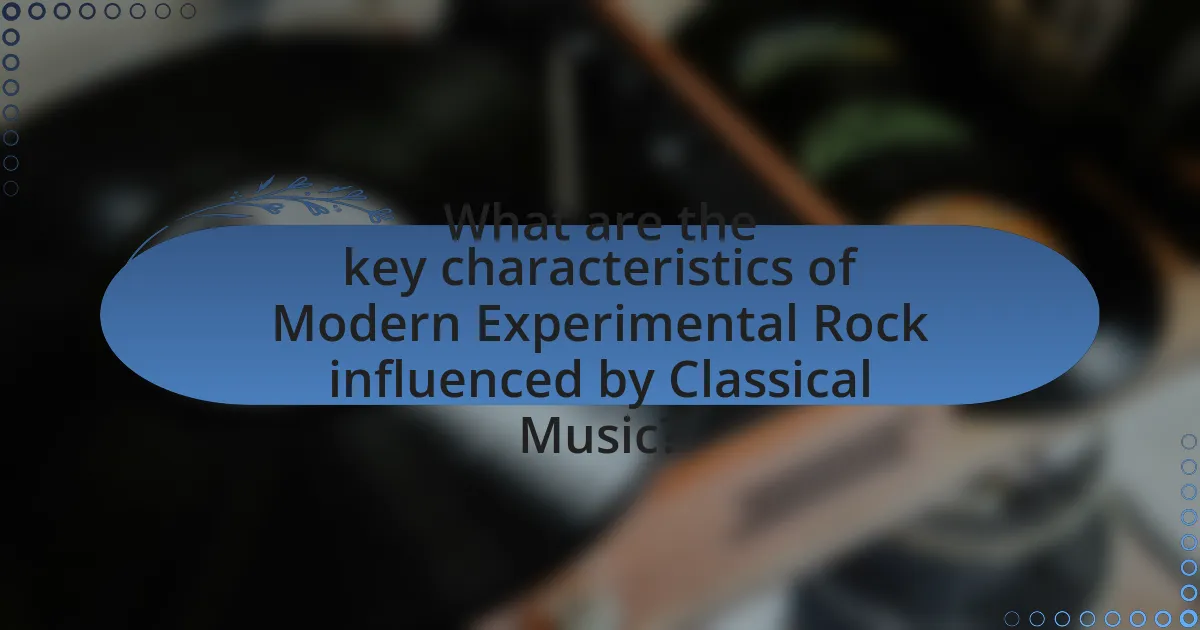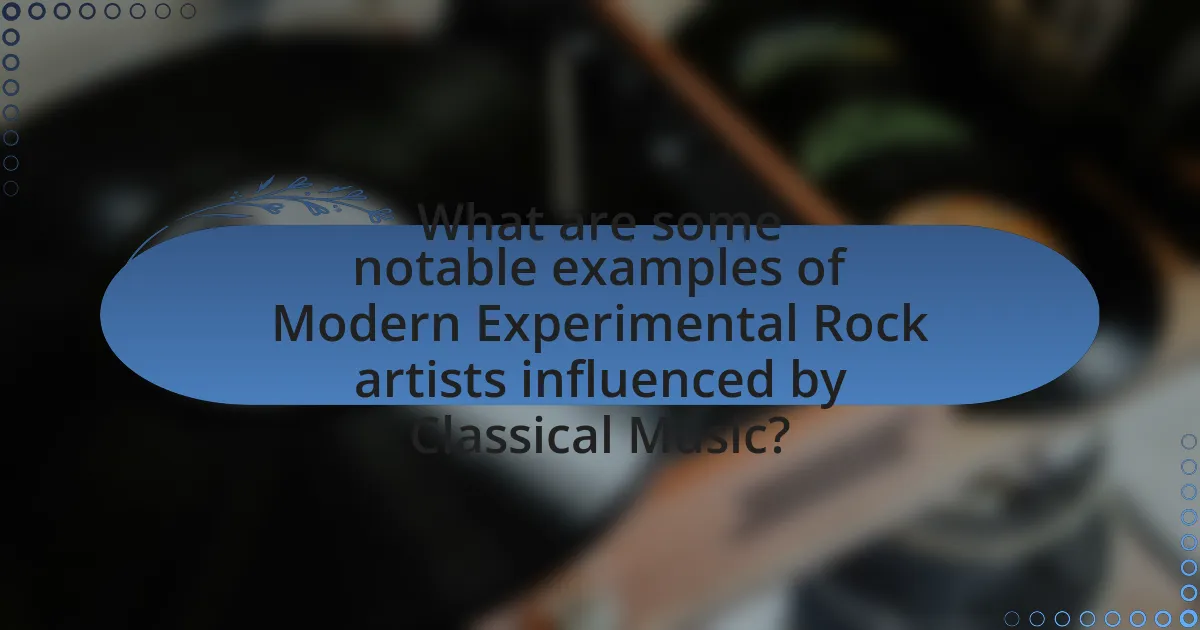The article examines the significant influence of classical music on modern experimental rock, highlighting how elements such as complex structures, orchestral arrangements, and diverse instrumentation have shaped the genre. It discusses specific techniques, including unconventional time signatures and thematic development, that artists like Radiohead and The Mars Volta incorporate into their music. Additionally, the article explores the cultural movements that have facilitated this fusion, notable artists and their contributions, and the impact of collaborations between classical musicians and rock artists. Overall, it emphasizes the importance of classical music in expanding the sonic palette and emotional depth of modern experimental rock.

What is the Influence of Classical Music on Modern Experimental Rock?
Classical music significantly influences modern experimental rock by introducing complex structures, orchestral arrangements, and diverse instrumentation. Artists in the experimental rock genre often incorporate elements such as symphonic melodies, counterpoint, and harmonic sophistication derived from classical traditions. For instance, bands like Radiohead and The Mars Volta utilize string sections and intricate compositions that echo classical techniques, enhancing their soundscapes. This fusion not only broadens the emotional range of the music but also challenges conventional rock norms, as seen in the use of unconventional time signatures and extended compositions, which are hallmarks of classical music.
How has classical music shaped the sound of modern experimental rock?
Classical music has significantly shaped the sound of modern experimental rock by introducing complex structures, orchestral instrumentation, and innovative compositional techniques. Bands such as Radiohead and The Mars Volta incorporate elements like intricate time signatures and lush arrangements, which are hallmarks of classical music. For instance, Radiohead’s “Paranoid Android” features multiple sections that shift in mood and tempo, reminiscent of classical symphonic movements. Additionally, the use of string arrangements in tracks like The Mars Volta’s “L’Via L’Viaquez” showcases the influence of orchestral sounds, blending rock with classical textures. This fusion not only expands the sonic palette of experimental rock but also challenges traditional rock conventions, creating a more dynamic and layered listening experience.
What specific elements of classical music are incorporated into experimental rock?
Experimental rock incorporates specific elements of classical music such as orchestral arrangements, complex time signatures, and thematic development. Orchestral arrangements often include strings, brass, and woodwinds, enhancing the texture and depth of the music, as seen in works by bands like The Beatles and Radiohead. Complex time signatures, which deviate from standard 4/4 time, create unique rhythmic structures, a technique utilized by bands like King Crimson. Thematic development, where musical ideas evolve throughout a piece, mirrors classical composition techniques, evident in the progressive rock genre. These elements demonstrate the significant influence of classical music on the experimental rock genre.
How do composers and musicians blend classical techniques with rock elements?
Composers and musicians blend classical techniques with rock elements by incorporating orchestral arrangements, complex harmonies, and varied time signatures into rock compositions. For instance, bands like Electric Light Orchestra and Muse utilize string sections and classical instrumentation alongside traditional rock setups, creating a fusion that enhances the emotional depth and complexity of their music. Additionally, the use of counterpoint, a hallmark of classical music, can be found in rock songs, allowing for intricate melodic interplay. This blending is further evidenced by the success of albums such as “Days of Future Passed” by The Moody Blues, which seamlessly integrates symphonic elements with rock, demonstrating the viability and appeal of this hybrid approach.
Why is the fusion of classical music and experimental rock significant?
The fusion of classical music and experimental rock is significant because it creates a unique sound that expands the boundaries of both genres. This blending allows for complex compositions and innovative arrangements, which can lead to new emotional and intellectual experiences for listeners. For instance, bands like The Beatles incorporated orchestral elements in their work, notably in “Eleanor Rigby,” showcasing how classical instrumentation can enhance rock music’s depth. Additionally, artists such as Radiohead have utilized classical influences to create atmospheric soundscapes, demonstrating the versatility and richness that this fusion brings to modern music.
What cultural or artistic movements have influenced this fusion?
The fusion of classical music and modern experimental rock has been influenced by several cultural and artistic movements, notably the Romantic movement, Minimalism, and the avant-garde. The Romantic movement, which emphasized emotional expression and individualism, inspired rock musicians to incorporate complex harmonies and orchestral arrangements into their work. Minimalism, emerging in the mid-20th century, introduced repetitive structures and a focus on tonal clarity, which have been adopted by experimental rock artists to create immersive soundscapes. Additionally, the avant-garde movement challenged traditional music forms, encouraging rock musicians to explore unconventional techniques and instrumentation, further blending the boundaries between classical and rock genres.
How does this influence reflect broader trends in music history?
The influence of classical music on modern experimental rock reflects broader trends in music history by showcasing the fusion of diverse genres and the evolution of musical complexity. This trend is evident in the incorporation of orchestral arrangements, intricate compositions, and thematic depth found in works by bands like Radiohead and The Mars Volta, which draw directly from classical techniques. Historically, the blending of genres has been a hallmark of musical innovation, as seen in the works of composers like Igor Stravinsky and bands like The Beatles, who integrated classical elements into popular music. This cross-pollination illustrates a continuous dialogue between genres, pushing the boundaries of creativity and expanding the sonic palette available to artists.

What are the key characteristics of Modern Experimental Rock influenced by Classical Music?
Modern Experimental Rock influenced by Classical Music is characterized by complex structures, orchestral instrumentation, and a blend of genres. These elements manifest through the use of unconventional time signatures, extended compositions, and the incorporation of classical instruments such as strings and brass alongside traditional rock setups. Additionally, the genre often explores thematic depth and emotional nuance, drawing from classical music’s rich harmonic language and dynamic contrasts. This fusion is evident in works by artists like Radiohead and The Mars Volta, who integrate classical techniques to enhance their sonic landscapes, demonstrating the significant impact of classical music on the evolution of modern experimental rock.
What musical techniques are commonly used in this genre?
Modern experimental rock commonly employs techniques such as complex time signatures, unconventional song structures, and the integration of orchestral instruments. These techniques reflect the influence of classical music, which often features intricate arrangements and varied dynamics. For instance, bands like Radiohead and The Mars Volta utilize polyrhythms and extended instrumental sections, drawing from classical traditions to create a rich auditory experience. Additionally, the use of dissonance and modal scales, prevalent in classical compositions, is frequently found in the works of experimental rock artists, enhancing emotional depth and complexity.
How do time signatures and rhythms differ from traditional rock?
Time signatures and rhythms in modern experimental rock often differ from traditional rock by incorporating complex and unconventional patterns. Traditional rock typically relies on straightforward time signatures like 4/4, creating a steady and predictable rhythmic foundation. In contrast, modern experimental rock frequently utilizes irregular time signatures such as 5/4, 7/8, or even 13/16, which can create a more dynamic and unpredictable listening experience. This shift is influenced by classical music, where composers often employed varied time signatures to enhance emotional expression and complexity. For example, bands like Radiohead and Tool have been noted for their use of these intricate rhythms, showcasing how classical elements can reshape the rhythmic landscape of rock music.
What role do orchestral instruments play in modern experimental rock?
Orchestral instruments in modern experimental rock serve to enhance the sonic landscape, adding depth and complexity to compositions. These instruments, such as strings, brass, and woodwinds, contribute rich textures and emotional resonance, allowing artists to explore innovative soundscapes. For instance, bands like Radiohead and The Mars Volta have incorporated orchestral arrangements to create atmospheric layers that traditional rock instrumentation alone cannot achieve. This blending of genres not only broadens the appeal of experimental rock but also reflects a growing trend where classical elements are used to challenge conventional rock structures, as evidenced by the increasing collaborations between rock musicians and orchestras in live performances and recordings.
How do lyrics and themes in modern experimental rock reflect classical influences?
Lyrics and themes in modern experimental rock reflect classical influences through their complex structures, rich narratives, and emotional depth. Many contemporary experimental rock artists incorporate classical music elements, such as orchestral arrangements and intricate time signatures, which enhance the storytelling aspect of their lyrics. For instance, bands like Radiohead and The Mars Volta often utilize motifs and harmonic progressions reminiscent of classical compositions, creating a layered listening experience that echoes the emotional intensity found in classical music. Additionally, the thematic exploration of existentialism, human experience, and philosophical questions in songs aligns with the profound subject matter often addressed in classical works, demonstrating a clear lineage from classical traditions to modern experimental rock.
What literary or philosophical themes are prevalent in this genre?
The prevalent literary and philosophical themes in the genre of modern experimental rock influenced by classical music include the exploration of identity, the nature of existence, and the interplay between chaos and order. These themes manifest through complex compositions that challenge traditional song structures, reflecting existential inquiries and emotional depth. For instance, the use of dissonance and unconventional time signatures often symbolizes the struggle between individual expression and societal norms, echoing philosophical ideas from thinkers like Friedrich Nietzsche and Jean-Paul Sartre. Additionally, the incorporation of classical elements serves to bridge historical context with contemporary issues, reinforcing the genre’s thematic richness.
How do these themes compare to those found in classical music?
Themes in modern experimental rock often parallel those found in classical music, particularly in their exploration of complex emotions and intricate structures. Both genres utilize thematic development, contrasting dynamics, and innovative instrumentation to convey depth. For instance, classical compositions by composers like Beethoven and Stravinsky exhibit dramatic contrasts and thematic evolution, which can also be observed in the works of experimental rock artists such as Radiohead and King Crimson. These artists incorporate orchestral elements and unconventional time signatures, reflecting classical influences while pushing the boundaries of rock music.

What are some notable examples of Modern Experimental Rock artists influenced by Classical Music?
Notable examples of Modern Experimental Rock artists influenced by Classical Music include Radiohead, The Mars Volta, and Steven Wilson. Radiohead incorporates orchestral arrangements and complex structures reminiscent of classical compositions, particularly evident in albums like “OK Computer” and “Kid A.” The Mars Volta blends progressive rock with classical elements, utilizing intricate time signatures and symphonic instrumentation in works such as “Frances the Mute.” Steven Wilson, known for his solo work and as a member of Porcupine Tree, often integrates classical influences through lush arrangements and thematic depth, as seen in albums like “Hand. Cannot. Erase.” These artists exemplify the fusion of classical music’s complexity and experimental rock’s innovative spirit.
Which artists are recognized for their classical influences?
Artists recognized for their classical influences include Frank Zappa, who incorporated complex orchestral arrangements and classical forms into his rock compositions, and Radiohead, known for their use of string arrangements and harmonic structures reminiscent of classical music. Additionally, the band Muse often integrates classical elements in their music, particularly in their grandiose arrangements and thematic depth. These artists exemplify the blending of classical techniques with modern rock, showcasing the enduring impact of classical music on contemporary genres.
What specific works showcase this influence effectively?
Specific works that showcase the influence of classical music on modern experimental rock include “The Dark Side of the Moon” by Pink Floyd and “In the Court of the Crimson King” by King Crimson. “The Dark Side of the Moon” incorporates complex time signatures and orchestral arrangements, reflecting classical music’s structural sophistication. Similarly, “In the Court of the Crimson King” features symphonic elements and intricate compositions, demonstrating the blending of rock with classical influences. These albums exemplify how classical music has shaped the sound and complexity of modern experimental rock.
How have these artists contributed to the evolution of the genre?
These artists have contributed to the evolution of the genre by integrating classical music elements into modern experimental rock, thereby expanding its sonic palette. For instance, bands like Radiohead and The Mars Volta have utilized orchestral arrangements and complex time signatures, which are hallmarks of classical music, to create innovative soundscapes. This fusion has led to a broader acceptance of diverse musical influences within rock, as evidenced by the incorporation of string sections and intricate compositions in albums such as Radiohead’s “OK Computer” and The Mars Volta’s “Frances the Mute.” Their work demonstrates how classical techniques can enhance emotional depth and complexity in rock music, influencing a new generation of artists to explore similar avenues.
What collaborations exist between classical musicians and experimental rock artists?
Collaborations between classical musicians and experimental rock artists include notable projects such as the partnership between composer Philip Glass and the band The Who, where Glass arranged orchestral versions of their music. Another significant collaboration is between the band Radiohead and the orchestral composer and conductor Jonny Greenwood, who has incorporated classical elements into their albums and live performances. Additionally, the collaboration between the Kronos Quartet and various rock artists, including the band The National, showcases the blending of classical string arrangements with experimental rock sounds. These collaborations illustrate the cross-pollination of genres, enhancing the complexity and depth of modern experimental rock through classical influences.
How do these collaborations enhance the musical experience?
Collaborations between classical musicians and modern experimental rock artists enhance the musical experience by blending diverse musical techniques and emotional depth. This fusion allows for innovative soundscapes that incorporate the complexity of classical arrangements with the raw energy of rock, creating a richer auditory experience. For instance, the use of orchestral instruments in rock music can elevate the emotional intensity of a song, as seen in works by bands like The Mars Volta, which often integrate string sections to add layers of texture and depth. Such collaborations not only expand the creative possibilities for artists but also attract a wider audience, bridging the gap between genres and fostering a greater appreciation for both classical and modern music.
What are some memorable performances or recordings from these collaborations?
Memorable performances and recordings from collaborations between classical musicians and modern experimental rock artists include the album “Screaming for Vengeance” by Judas Priest, which features orchestral arrangements that enhance the heavy metal sound. Another notable example is the collaboration between the band The Mars Volta and the classical guitarist John Frusciante, resulting in the album “The Bedlam in Goliath,” which incorporates complex time signatures and orchestral elements. Additionally, the performance of “The Rite of Spring” by Igor Stravinsky, reinterpreted by the band The Bad Plus, showcases a fusion of jazz and classical influences that resonates within the experimental rock genre. These examples highlight the significant impact of classical music on the evolution of modern experimental rock.
What practical tips can aspiring musicians use to incorporate classical influences into their experimental rock music?
Aspiring musicians can incorporate classical influences into their experimental rock music by integrating orchestral instruments, utilizing classical compositional techniques, and studying classical music theory. For instance, adding strings, brass, or woodwinds can create rich textures and depth, as seen in works by bands like The Mars Volta, who blend rock with orchestral elements. Additionally, employing techniques such as counterpoint and thematic development, which are foundational in classical music, can enhance the complexity of rock compositions. Furthermore, analyzing the structures of classical pieces, such as sonatas or symphonies, can inspire innovative arrangements and transitions in rock songs, allowing musicians to create a unique fusion that respects both genres.